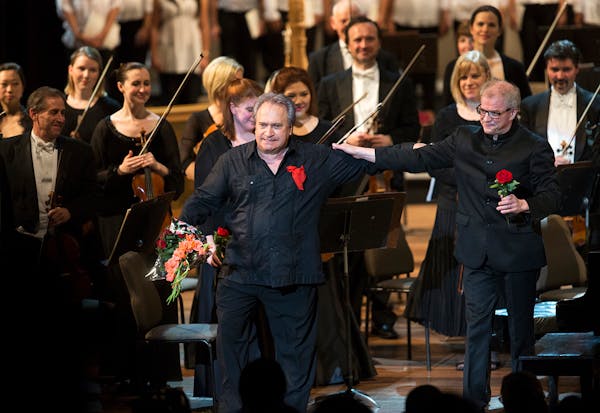HAVANA – Their day started in a cigar factory, included a reception at the residence of the chief U.S. diplomat and ended with the Minnesota Orchestra's first concert on Cuban soil.
In addition to 100 musicians and staff members, a group of about 25 patrons and board members are traveling with the Minnesota Orchestra on its historic trip to Havana.
They are designated as "cultural ambassadors," a State Department requirement for a "people-to-people license," one of the ways for U.S. citizens to travel to this island nation, which is still under a trade embargo with the United States.
On another level, their presence is part of the healing the Minnesota Orchestra is going through after the 16-month lockout that ended in February 2014. Traveling is a bonding experience — as the musicians, board members, donors and community supporters are finding out. The Cuba trip is historic not only on diplomatic and national terms, but also because of the personal capital it has developed.
"The opportunity to interact is priceless," said longtime board member Luella Goldberg. "You get to know one another."
Referring to a joyous dinner the previous night in Cathedral Square in Old Havana, Goldberg said, "That was visible evidence."
Goldberg's daughter, Ellen Luger, whose involvement with the orchestra stretches back to mailing invitations to the opening of Orchestra Hall in 1974, said the trip is an opportunity to "break down barriers."
Cy and Paula DeCosse, key instigators of the Orchestrate Excellence movement started during the lockout, immediately jumped at the chance to join the trip.
"This is a microcosm of what can happen with the orchestra," said Paula DeCosse. "We know we have to work hard and cooperate."
This is culture
Dianne Brennan, the orchestra's director of development, said the daily agenda for the 25 Minnesotans needed to be approved by both the U.S. and Cuban governments as activities that counted for cultural significance.
And how does the cigar factory fit in?
"That was the only thing that was nonnegotiable," said Brennan. "The Cuban ministry insisted, because it is such a part of the heritage and identity of the people."
So, the group — consisting of orchestra board members, donors and community supporters — huffed up five flights of smelly staircases at the Partagás tobacco factory to peer into the process as workers sat at rows of what appeared to be secretary desks, pulling shreds of tobacco from different leaves and rolling them together in what appears to be a sleight of hand before producing a perfect stogie.
A guide admonished the Americans as they left the factory: Never stub out a cigar in an ashtray. Rest it and let it die with dignity.
From there, the group listened to the orchestra play a side-by-side rehearsal with conservatory students. They shared stands and music and in some cases instruments. Principal cellist Tony Ross let his student mate play his instrument, and Ross used the Cuban cello.
Music director Osmo Vänskä pushed the huge orchestra, numbering close to 200, through Prokofiev's "Romeo and Juliet" ballet, which will be performed Saturday night.
After a break, the conservatory conductor, Guido López-Gavilán, took the podium to lead the ensemble through his own composition, which uses the Cuban rumba as a rhythmic impulse. He was eager to hear the piece with full symphonic heft, though he admitted a few nerves.
"It's good to be nervous," he said. "It's quite impossible not to be nervous."
Musical diplomacy
The visit to the residence of Ambassador Jeffrey DeLaurentis, who leads the U.S. Interests Section in Cuba, was the Minnesota group's one footfall on American property in Havana. A midafternoon reception drew diplomats from Nigeria, the Netherlands and perhaps obviously Sweden.
"I felt I had to be here because this is Minnesota," said Elisabeth Eklund, who was trading stories with orchestra patron Marilyn Carlson Nelson in the spacious foyer of the mansion. "Even though this is a U.S.-Cuban thing, it has a Swedish feeling to it."
Eklund and Norbert W.M. Braakhuis, the Dutch ambassador, were searching for tickets for Friday night's sold-out concert. "This is not just a historic event but a musical event," Braakhuis said. "I am a music lover."
He was fortunate, because moments later a trio of Minnesota musicians — concertmaster Erin Keefe, first associate concertmaster Susie Park and violist Rebecca Albers — played Dvorak's Terezetto for the people-to-people group and the visiting dignitaries.
More Cuban culture awaited with a tour in the old American cars that have become emblems of Cuba's stasis. They are beautifully preserved on the outside but mechanical nightmares. A guide laughed at the fascination outsiders hold for the candy-colored Oldsmobiles, Chevys and Buicks. "We hate them," he said.
Regardless, the car tour was a chance for the group to be immersed in Havana life before spending the evening listening to Minnesota musicians.
"Watching the side-by-side rehearsals, with Osmo conducting, I got chills this morning," said Luger, and she was not referring to the weather. "What a special opportunity for us to watch this historic moment. It's a shared experience."
Graydon Royce • 612-673-7299
Movie Review: A lyrical portrait of childhood in Cabrini-Green with 'We Grown Now'
Judge declines to dismiss lawsuits filed against rapper Travis Scott over deadly Astroworld concert

Summer Movie Guide: Virtually all the movies coming to theaters and streaming from May to Labor Day

